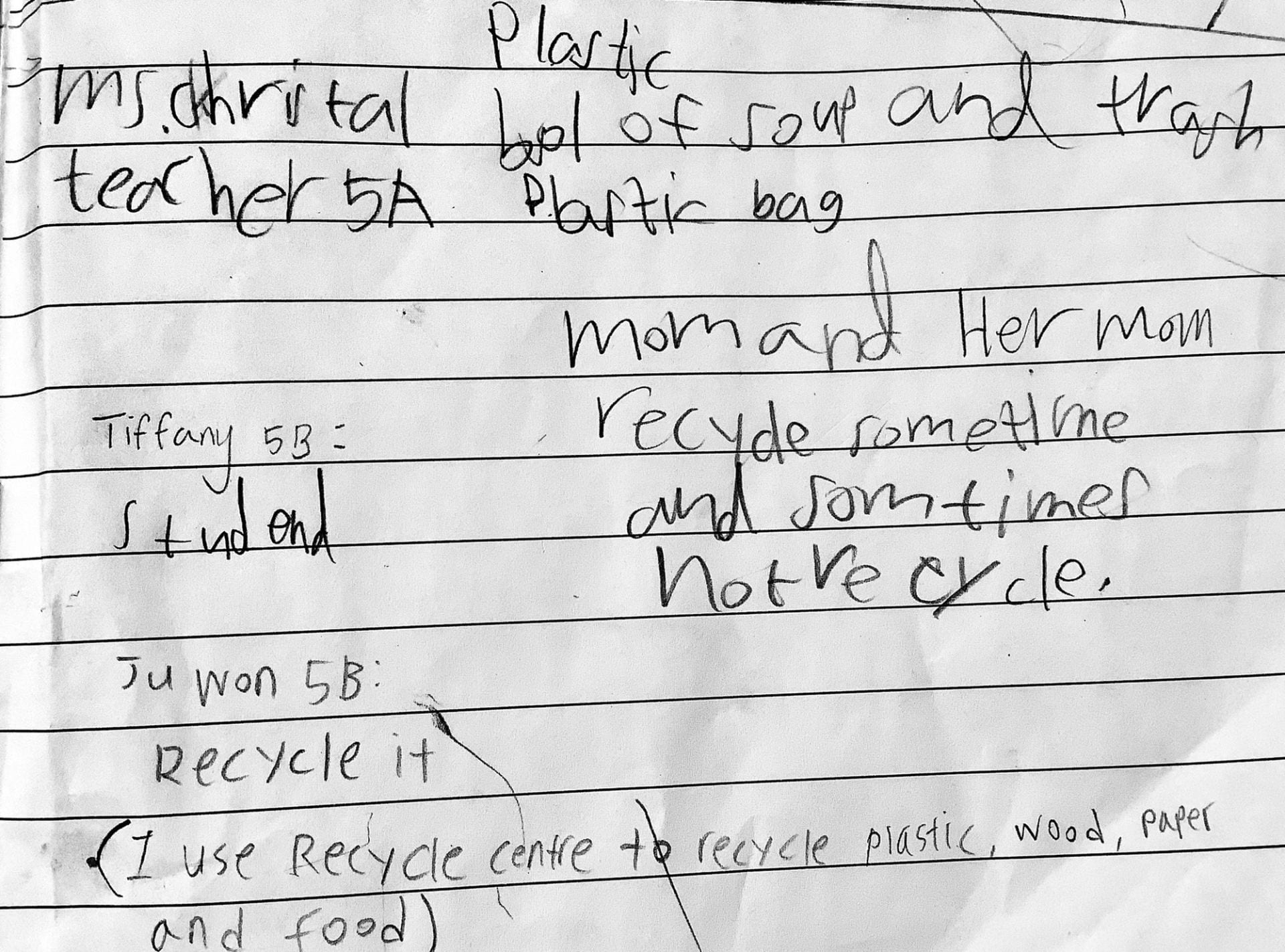How We Organise Ourselves 2021-22
The Central Idea:
To maximize efficient use of resources we can minimize waste.
Lines of Inquiry:
- how people create waste
- waste management
- connections between waste and natural resources
Key Concepts: Causation, Responsibility
Related Concepts: Choices, Consequences
Story#1
- What is waste?
- What waste do you produce?
The students noted down their initial responses to the two questions. All student responses were shared and a table was created to show the WHAT we waste.
A student in a Grade 5 was conducting a survey on single use plastics. We gathered to discuss and answer the survey, making note of the different types of single use plastic we use and the waste we create as individuals and as a community. We made a list of the items we might use.
Plastic:
- straws
- disposable food containers
- cutlery
- cups
- bottles
- garbage bags
- shopping bags
- packaging
We made a list of the waste we produce or the things we waste.
 Then, we included this information on a graph to help us orgainse our information. We learned that the two things we waste the most are food and time.
Then, we included this information on a graph to help us orgainse our information. We learned that the two things we waste the most are food and time.
We were looking at describing how and why we produce waste. We included some language to help us explain the reasons why using language for cause beyond ‘because’ (since, as, so, therefore) and language that helps us show contrast (although and even though).
 The class came up with some wonderful ideas to improve their writing on the topic.
The class came up with some wonderful ideas to improve their writing on the topic.
What happens to the waste we produce?
Story#2
What waste do you produce?
We took a closer look at our morning snacks to think about the different types of waste we produce. The students took a photograph of their snacks before and after they ate. Then, they discussed what they had noticed.
- Even the banana peel is waste.
- The food that drops on the ground then goes to waste.
We paused to think about the different ideas shared. We decided to sort and collect our waste for the day.
We could see how the students were wondering about the journey of waste. They documented what they know about the journey of waste.
What happens to the waste we produce?
Story#3
Waste – Data Collection
Where does all the waste go?
The students had differing views on what happens to the waste we produce. We gathered to discuss and document these ideas on chart paper.
The Power of Images
Our inquiry into waste has been thought provoking and engaging. We watched 2 videos to help us tune into the ways we produce waste and the impact it has on the world around us. The first, was a video to mark ‘Earth Day’ and the second, a documentary on the journey of plastic bottles. While watching the video, the students took notes, using pictures, labels, sentences and words, to capture important ideas shared in the video.
Next, an image with icons was shared.
The students were asked to work in teams to guess what messages the icons conveyed. They worked with their partners to decide on the labels they would attach to the images. The students explained their ideas, making connections with what they have seen, think or already know.
The students have been writing questions to help them learn more about waste management. They have been conducting interviews, gathering data and taking notes to capture different perspectives and information shared by the community.




 The students will continue to document their learning and present their findings on waste. Focused literacy sessions on word choice and grammar helped the students improve their pieces of writing.
The students will continue to document their learning and present their findings on waste. Focused literacy sessions on word choice and grammar helped the students improve their pieces of writing.
We continue to discuss and explore the impact our actions have on the environment as we consider the action we can take as a result of our learning.
Story#4
Powerful Messages about Waste
How might we communicate a powerful message?
How might powerful images communicate important information?
The students were invited to create the own powerful messages. They used their notes from previous research to think about the important information they wanted to share with others. The students were encouraged to reflect on the issue of ‘waste‘, and think about the action they could take as a result of their learning.
 The students went through the writing process to create a first draft. Then, they revised and edited their writing in order to publish their final piece of work. Next, a drawing that communicated a powerful message was created. Finally, we used a green screen to produce a video. The students continued to work on speaking confidently, expressing ideas and information in order to inform and engage an audience.
The students went through the writing process to create a first draft. Then, they revised and edited their writing in order to publish their final piece of work. Next, a drawing that communicated a powerful message was created. Finally, we used a green screen to produce a video. The students continued to work on speaking confidently, expressing ideas and information in order to inform and engage an audience.
WASTE
Student in G2 @NISChina reflected on the issue of 'waste', and presented their powerful messages through words and pictures. https://t.co/x4obYIehKm pic.twitter.com/YabHMrOMyk— Shemo Gani (@shemogani) May 30, 2022



















































